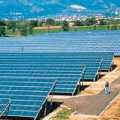|
作者 傑奇•艾倫•朱利安諾 博士
他們已經失去了
而他們的孩子也不再期待
這一切讓人害怕
因為這些日子以來
太陽依舊升起
但沒有人再為此歌唱
-- 阿倫•克萊曼
真的是因為缺乏良好技術,才使得太陽能無法進入主流市場?還是因為我們的經濟體系,寧可耗盡地球上最後一點化石燃料,也不願使用太陽這顆離我們最近恆星所散發的光亮?
陽光,我們最基本的能源,它的利用其實已經行之千年,並不是什麼新穎的科技。早自古希臘以來,住屋向陽吸熱的觀念,一直影響著社區的設計。隨著城市興起,木質燃料的供給迅速減少,能源危機一觸即發,西元前四世紀的商人,便靠著控制木材與相關進出口的市場而得勢,貪婪可不是現代社會才有的產物。

義大利的現代太陽能板陣列。(照片提供 綠色和平組織)
在許多考古遺址中,發現了使用太陽能的證據,那些建築物設計便是以善用太陽為考量。向陽的房子可以節約木材與煤炭的使用,也可省下不少錢。
西元四世紀時,小亞細亞的普里內城,四千位居民為了避開頻仍的洪水,遷居至山邊,而整個新城市的設計與排列就兼顧到太陽的走向,使得當地居民住起來能夠冬暖夏涼。
到了十七、八世紀,玻璃使得太陽熱力的利用變得更有效率,太陽能的引擎和機器,也都應運而生,其中還包括太陽能蒸汽引擎以及太陽能煮沸器。西元1912年時,埃及出現了一座大型太陽能發電廠,每分鐘能夠抽六千加侖的水,產生55馬力。這種新穎且成本低廉的發電方式,取代了原本骯髒的燃煤發電。
1914年第一次世界大戰爆發,工程師與工人紛紛抽身離開太陽能工作,回到自己的國家準備戰事,因而終止了全球太陽能發展計畫的風潮。
這時期發現的巨量油田與天然氣,再度降低發展太陽能計畫的可能性。石油與天然氣的售價低廉,各國政府與商人對能源的取得都感到滿意,今日許多的大型石油公司,便是由20世紀初成為油商的地主組成的。
在此同時,太陽能熱水器也趕上了時代潮流,1941年時,大半的邁阿密與佛羅里達居民家中都設有此裝置,其中包含80%的新房子。但是二次大戰的爆發以及在非軍事設施對銅的禁用,則幾乎斷絕了這項新穎電價低的工業。
在1950和1960年代,美國的天然氣與電力公司,以「用越多省越多」的促銷手法,鼓勵大眾盡量使用能源,這樣的策略果然奏效,天然氣與其它燃料在1950到1965年間的產量加倍。而在一度(每千瓦小時)兩分錢的收費標準下,根本不會有任何誘因去發展更省電的家電用品。
【文章連載】
■讓太陽能重見天日 (上) (下)
全文與圖片詳見: http://ens-news.com/ens/jun2001/2001L-06-15g.html
版權歸屬Environment News Service(ENS),環境資訊協會( 王惟芬譯, 蘇崧棱、蔡麗伶 審校)
中英對照譯稿請見:http://e-info.org.tw/issue/energy/
2001/sub-energy01090401.htm
|
|
By Jackie Alan Giuliano, Ph.D
They've lost it, lost it,
and their children
will never ever wish for it -
and I am afraid ..
because the sun keeps rising
and these daysnobody sings.
-- Aaron Kramer
Is it really a lack of the right technology that is keeping solar power off the mass market? Or is the light from our nearest star, the Sun, being held hostage by an economy that is devoted to using up the Earth's last drops of fossil fuel at all cost?
Using the light from the Sun, our ultimate energy source, is not a new technology at all, but has been around for thousands of years. Passive solar heating, orienting a dwelling to take advantage of the sun, has influenced the design of communities from the times of ancient Greece. Fuel wood supplies quickly dwindled as cities grew and an energy crisis was soon at hand. In the 4th century B.C., merchants rose to power by controlling wood supplies and cornering export and import markets. Greed is not a modern invention.

Modern solar power array in Italy (Photo courtesy
Greenpeace)
Evidence of the use of solar architecture, the design of buildings to make best use of the Sun, has been found in many excavations. A solar oriented home conserved the use of wood and coal and saved money.
In the 4th century A.D., all of the 4,000 residents of the city of Priene in Asia Minor relocated their homes to nearby Mount Mycale to escape frequent floods. An entirely new city was designed and oriented so that they could enjoy the warmth of the Sun in winter and be spared its heat in summer.
The use of glass in the 17th and 18th centuries was a way to capture the heat of the Sun efficiently. Soon, solar engines and machines were devised, including a solar powered steam engine, and a solar boiler. A massive solar power plant was built in Egypt in 1912. This plant could pump 6,000 gallons of water per minute and generate 55 horsepower. Plans were underway to replace dirty coal with this new, cheaper form of energy.
The onset of World War I in 1914 ended that wave of solar development projects around the world, as engineers and workers left their jobs in sunny climates to do war related work in their homelands.
At this point, huge oil and natural gas fields were discovered, eliminating the to continue solar power development. Oil and gas were selling at giveaway prices, and the world's governments and business people became complacent over the availability of energy. Many of the land barons who became the oilmen of the early 20th century formed the huge energy companies we have today.
Also around this time, solar powered water heaters were really catching on. More than half the population of Miami, Florida had them by 1941, including 80 percent of the new homes built. But World War II and the prohibition on non-military uses of copper nearly ended the industry in favor of new, cheap electricity.
In the 1950s and 1960s, U.S. gas and electric utilities promoted heavy consumption in their advertising campaigns. Lower prices were given to those who used more energy! The campaigns worked, and natural gas and other fuel production doubled between 1950 and 1965. With prices at two cents per kilowatt-hour, there was absolutely no incentive to create energy efficient appliances.
http://ens-news.com/ens/jun2001/2001L-06-15g.html |
